|
|
|
|

|
|
7 LUCKY GODS MENU
Intro Page
Benzaiten 
Bishamonten
Daikokuten
Ebisu
Fukurokuju
Hotei
Jurōjin
Benzaiten Spellings
Jp. = Benzaiten 弁才天, 弁財天
Jp. = Myōon Ten 妙音天
Jp. = Daibenzaiten 大弁才天
Jp. = Bionten 美音天
Jp. = Benten 弁天
Skt. = Sarasvatī, Sarasvati
Chn. = Biàncáitiān 辯才天, 瓣財天
Chn. = Miàoyīn Tiān 妙音天
Krn. = Byeonjaecheon 변재천
Krn. = Myoeum Cheon 묘음천
Tbt. = Sbyaṅs-can-ma
Tbt. = Ńag-gi-lha-mo
Benzaiten Mantra
おん そらそばていえい そわか
On Sorasobatei-ei Sowaka
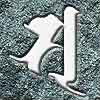
Benzaiten Sanskrit Seed
Pronounced SO in Japan
|
|

BENZAITEN, BENZAI-TEN, BENTEN
Goddess of Music, Poetry, Learning, & Art
River Goddess, Patron of Children
Protector of the Nation
Origin India
Shinto Association = Kami Itsukushima Hime
Member of the TENBU
One of Japan’s Seven Lucky Deities
Associations: The Naga (Snakes & Dragons)
Associated Virtue = Amiability
- Other Japanese names: Happi (8-Armed) Benzaiten 八臂弁財天, Daibenzaiten 大弁才天, Myōonten 妙音天 (Heavenly Sound Deva), Bionten 美音天 (Beautiful Sound Deva), and Benten 弁天.
- In Japan, worship of Goddess Kichijouten and Goddess Marishiten has been largely supplanted by Benzaiten worship.
- Chinese: Biàncáitiān, Pien-ts'ai-t'ien, 辯才天, 瓣財天
Miàoyīn Tiān, Miao-yin T'ien, 妙音天
- Korean: Byeonjaecheon, Pyŏnjaech'ŏn, 변재천
Myoeum Cheon, Myoŭm Ch'ŏn, 묘음천
- Tibetan: Sbyaṅs-can-ma, Ńag-gi-lha-mo
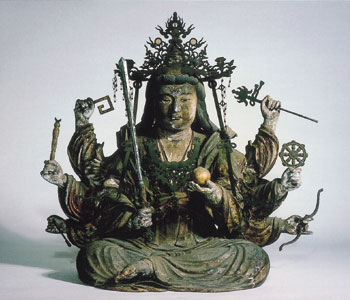
8-Armed Benzaiten (Jp. = Happi Benzaiten 八臂弁財天)
At Hoan-den (Enoshima Island in Japan)
Kanagawa Pretectural Asset, Kamakura Period
Legend says Shogun Minamoto no Yoritomo asked the
Buddhist monk Mongaku to make this statue to curse his enemies.
Photo courtesy of Fujisawa City Tourist Association
WHO IS BENZAITEN. Female. A river goddess in Indian mythology. Her Sanskrit name "Sarasvatī" means "flowing water" and thus she represents everything that flows (e.g., music, words, speech, eloquence). Later adopted into the Buddhist and then Shinto pantheons of Japan. One of Japan's Seven Lucky Gods. Comes in two main forms: (1) with two arms holding a lute; (2) with eight arms holding martial implements to indicate her role as protector against disaster; this version is called Happi Benzaiten. In less-common forms she is depicted naked or as Uga Benzaiten (esoteric form). Her messenger is the snake, so she is sometimes shown mounted on a serpent or dragon. Goddess of Learning, Eloquence, Music, Poetry, Speech, Rhetoric, Wealth, Longevity; Protects against natural disaster; Inventor of Sanskrit; River Goddess.
Benzaiten is the sole female among the Seven Lucky Gods of Japan. Her temples and shrines are almost invariably in the neighborhood of water -- the sea, a river, or a pond. She is the patroness of music, the fine arts (dancing, acting, visual), and good fortune in general, and is often shown carrying a biwa (Japanese mandolin) or playing a lute. She is often represented as a beautiful woman with the power to assume the form of a serpent, or shown seated on a dragon or serpent and playing a lute. In fact, the snake is almost always associated with Benzaiten, who was originally a Hindu deity (Sarasvati) who represented learning, music and poetry. Such artistic learning and wisdom often bring prosperity, hence her inclusion in the Japanese group of seven luckies. She also has a jewel that grants desires. Some say it is a jade, while others say it is a pearl.
In India, her birthplace, she is called Sarasvatī (literally "flowing water"), which is the name of an actual Indian river. She is thus a Goddess of the River. She arrived in Japan soon after the introduction of Buddhism to this island in the 6th century, and her worship was based largely on her attributes as described in the Sutra of Golden Light (金光明最勝王経) as translated into Chinese by Yijing 義浄 in the 7th century. This sutra is regarded primarily as a scripture for state protection, wherein Benzaiten is described with eight arms that hold protective martial instruments including the bow, arrow, sword, ax, spear, long pestle, iron wheel, and silk rope.
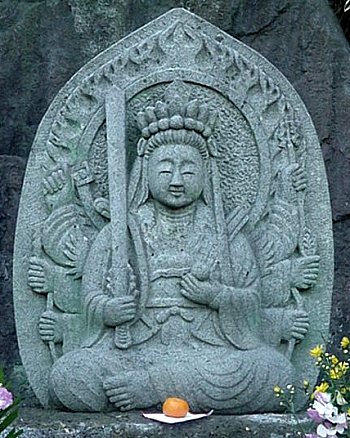
8-Armed Benzaiten (Jp. = Happi Benzaiten 八臂弁財天)
Stone, 8 arms, Hase Dera (Kamakura, Japan), Date Unknown
Hase Dera Temple claims it was made by Kobo Daishi

During Japan’s Kamakura period, artists began to represent Benzaiten with two arms and carrying a biwa (lute). Also, in the Kamakura era, artists for the first time began to create “naked” sculptures of Buddhist and Shinto deities. The object of their artistic talents was often Benzaiten, although other deities, like Jizo Bosatsu, were also sculpted in the nude.
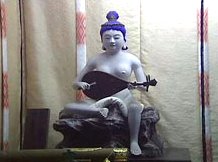 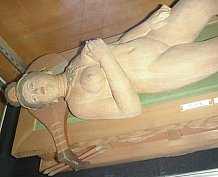
|
LEFT: Naked, Playing Lute
Myōon Ten 妙音天 (aka Benzaiten)
Hoan-den on Enoshima Island.
Photo courtesy this web site
|
RIGHT: Naked, Reclining
Benzaiten
Hase Dera Temple
Kamakura, Japan
|
|
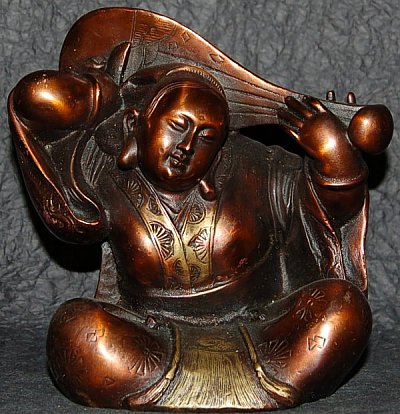
Benzaiten playing four-string lute. Modern metal statue.
Available for online purchase at Buddhist-Artwork.com
ANIMAL ASSOCIATIONS & SHINTO ASSOCIATIONS
The Snake, White Snake, Hakuja, Ugajin
On days of importance to the serpent in Japan, one can find many festivals at the numerous Japanese shrines and temples dedicated to Benzaiten (Benten), in which votive pictures with serpents drawn on them are offered. It is also said that putting a cast-off snake skin in your purse/wallet will bring you wealth and property.
Benzaiten appears in some artwork together with a sea dragon (see Sea Dragon below). In other depictions, Benzaiten is occasionally surrounded by white serpents, or crowned with a white serpent. Another Japanese deity, Suijin, of the Shinto pantheon, appears in some artwork in the form of a white snake. Like Benzaiten, Suijin is closely associated with water. Images of Benzaiten are also accompanied, although rarely, by a large white serpent with the head of an old man. This latter entity is called Hakuja 白じゃ (white serpent; also known as Ugajin 宇賀神), considered her companion. (Editor’s Note: Unable to confirm the Japanese spelling of Hakuja.) Even today, when many of the myths surrounding Benzaiten are mostly forgotten, the Japanese believe that seeing a white snake is an omen of great luck -- but not many will remember why. Says the Flammarion Iconographic Guides by Louis Frederic: “Ugajin, as a separate entity, usually appears in artwork as an old man surrounded by a large white snake, with only the head appearing.”
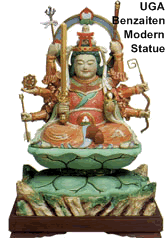 Uga Benzaiten 宇賀弁財天 Uga Benzaiten 宇賀弁財天
During Japan’s Heian era, the powerful Tendai sect on Mt. Hiei merged the Buddhist deity Benzaiten with an obscure local kami (spirit) named Ugajin (see photo at right) to create the syncretic deity known as Uga Benzaiten, a deity of good fortune and wealth. Most sources believe Ugajin is none other than Uga no Mitama, the Shinto goddess of foodstuffs mentioned in Kojiki and Nihongi, two of Japan’s earliest records. Uga no Mitama is also commonly identified with a male counterpart named Uka no Mitama, the deity of grains. This Shinto pair are further identified with Inari, the parent Shinto god/goddess of rice and agriculture, who is identified with a white fox as his/her messenger. Confused yet? Lump them all together, and you have the composite Buddhist/Shinto deity called Uga Benzaiten. For much more on Ugajin, please see the Kokugakuin University database. For more details in Japanese, visit this outside site.
UGA Benzaiten at Sacred Mt. Haguro The Sanjin Gosaiden of Dewa Sanzan Shrine was formerly the Main Hall of the Buddhist temple Jakkoji. The most sacred object of veneration here is a rock called Goshinpi, secreted below the floor of the shrine. In front of the shrine is a sacred pond called Mitarashi. More than 600 small votive bronze mirrors, dating from the 12th to the 18th century have been found here. Beside the pond is a shrine dedicated to Benzaiten, the goddess of eloquence, art, wealth and longevity. This deity is depicted with a kami of good fortune, called Ugajin, on its head. Ugajin has the face of an old man and the body of a snake.
MORE CONFUSION. To create further confusion, consider this. The symbolism and roles of Benzaiten and Ugjin are very similar to those associated with Inari, as mentioned above, the parent Japanese deity of agriculture and rice. Inari is a composite diety, merged with the Hindu/Buddhist guardian deity Dakiniten, and is generally depicted riding a white fox (sometimes with white snakes in his/hair). The similarities between Benzaiten and her white snake and the iconography of Inari/Dakiniten and the white fox are very striking. For more on Dakiniten, please click here.
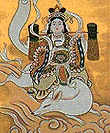 WHITE COLOR. Curiously, Inari 稲荷 (Japan’s Rice Deity), Uga Benzaiten 宇賀弁財天 (this page), and Daikoku-ten 大黒天 (Hindu God of Five Cereals, identified with Japan’s Shinto Oo-kuninushi-no-Mikoto 大国主命) each have messengers that are WHITE in color. Inari is often associated with a white fox, as is Dakiniten of Hindu mythology, Benzaiten with a white snake, and Oo-kuninushi with a white hare. Is this coincidental, or does it suggest a deeper relatedness? I believe it suggests a deeper pattern of shared iconography and origin. WHITE COLOR. Curiously, Inari 稲荷 (Japan’s Rice Deity), Uga Benzaiten 宇賀弁財天 (this page), and Daikoku-ten 大黒天 (Hindu God of Five Cereals, identified with Japan’s Shinto Oo-kuninushi-no-Mikoto 大国主命) each have messengers that are WHITE in color. Inari is often associated with a white fox, as is Dakiniten of Hindu mythology, Benzaiten with a white snake, and Oo-kuninushi with a white hare. Is this coincidental, or does it suggest a deeper relatedness? I believe it suggests a deeper pattern of shared iconography and origin.
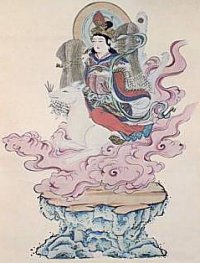
Dakiniten riding white fox
Found on web; no reference given
EDITOR’S NOTE: The white snake mentioned above is most often associated with the Goddess Benzaiten, who (like the Shinto deity Suijin) is worshipped as a water kami in Japan. Nearly all Benzaiten shrines and temples in Japan are located near a river, lake, pond, or ocean. They almost all have a water well, in which it is said lives a snake, the servant of Benzaiten. The Suiten-gu Shrine (Tokyo) actually worships Benzaiten together with Suiten/Suijin. Although confusing, it is not uncommon for Shinto deities and Buddhist deities to share similar attributes and appearances.
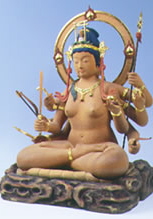
(R) Uga Benzaten, Nude
Inside Kamaishi Daikannon Complex
Kamaishi City, Iwate Prefecture

Sea Dragon and Enoshima Island
Below text courtesy of “Myths and Legends of Japan”
by F. Hadland Davis, first published in 1913 by
George G. Harrap & Company, London
Near Kamakura in a certain cave there lived a formidable dragon, which devoured the children of the village of Koshigoe 腰越. In the 6th century AD, Benzaiten was determined to put a stop to this monster’s unseemly behavior, and having caused a great earthquake she hovered in the clouds over the cave where the dread dragon had taken up his abode. Benzaiten then descended from the clouds, entered the cavern, married the dragon, and was thus able, through her good influence, to put an end to the slaughter of little children. With the coming of Benzaiten there arose from the sea the famous Island of Enoshima, which has remained to this day sacred to Benzaiten, the Goddess of the Sea. <end Hadland quote>
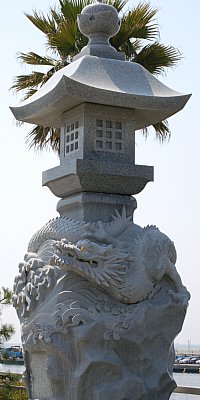 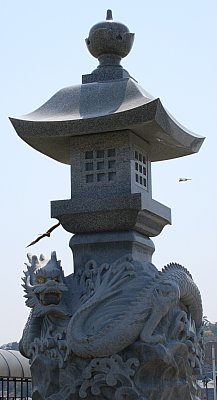
Dragon guardians protecting the bridge that
leads to Enoshima Island, which is sacred to Benzaiten

Benzaiten’s 16 Daughters
In Japan, Benzaiten is sometimes associated with 16 children, said to be incarnations of the various Buddhist deities who symbolize the crafts for which she is the patroness. At Hase Dera in Kamakura, a cave with 16 life-size statues, all female, is found on the ground level of the temple. If your computer can display Japanese, please visit this page to see images of the 16 children of Benzaiten at Daikakuji Temple. In other traditions, she is instead associated with 15 sons or disciples (see below). The latter tradition appears more in tune with traditional Buddhist mythology, while the former (the 16-daughter myth) seems to be a relatively recent Japanese invention.
More About the 16 Children of Benzaiten
(editor: below unconfirmed)
One story is that 15 Princes and one Princess set out from Japan, which at that time was still part of the ancient continent of Mu, to populate the world. They went to various parts of the globe and apparently their names are even similar to the names of the various continents and countries.
Benzaiten 弁才天
Fifteen (15) Sons or Disciples
Sixteen (16) Daughters or Disciples
Below Text Courtesy of JAANUS
http://www.aisf.or.jp/~jaanus/deta/b/benzaiten.htm
Also written 瓣財天. Skt. = Sarasvati. A Buddhist goddess of music, learning, eloquence, wealth, longevity, and protection from natural disasters. Among her many variant names are Daibenzaiten 大弁才天, Myouonten 妙音天, Bionten 美音天, and, most common, Benten 弁天. A river goddess in Indian mythology, she was adopted into Japan's Buddhist and then Shinto pantheons. This origin helps to explain why many Japanese temples and shrines dedicated to Benzaiten (including those at Itsukushima 厳島, Enoshima 江ノ島, and Chikubushima 竹生島 are located near water. As described in the KONKOUMYOU SAISHOUOUKYOU 金光明最勝王経 (translated into Chinese by Yijing 義浄 in 7c), Benzaiten has eight arms with hands that hold a bow, arrow, sword, ax, spear, long pestle, iron wheel, and silk rope. The earliest Japanese example, an 8th-century sculpture at the Sangatsudou 三月堂 of Toudaiji 東大寺 is of this type. In another form, Benzaiten is represented as a plump woman dressed in a flowing Chinese-style gown and holding a four-stringed lute, biwa 琵琶. This iconic type first became popular in the 13th century, a well-known example being the sculpture with wood body dressed in silk robes at Tsurugaoka Hachimanguu 鶴岡八幡宮. She is sometimes depicted seated on a white serpent. In esoteric Buddhism, Benzaiten was associated with Fifteen Sons or Disciples, Juugo Douji 十五童子. They are:
- Aikyou 愛敬
- Hanki 飯櫃
- Hikken 筆硯
- Guiba 牛馬
- Inyaku 印鑰
- Juusha 従者
- Keishou 計升
- Konsai 金財
- Kantai 官帯
- Sanyou 蠶養
- Sensha 船車
- Shusen 酒泉
- Shoumyo 生命
- Touchu 稻籾
- Zenzai 善財
- Editor’s Note: At Hase Dera in Kamakura, Benzaiten is associated with 16 Daughters or Disciples.
Benzaiten gained in popularity during the Muromachi period (1392-1568). By the Edo period (1600-1868), her large following among the merchant and urban classes ensured her inclusion among the Seven Gods of Good Fortune (Shichifukujin 七福神), and new temples and shrines were dedicated to her. Benzaiten is often confused with Kichijouten 吉祥天. <end JAANUS quote>
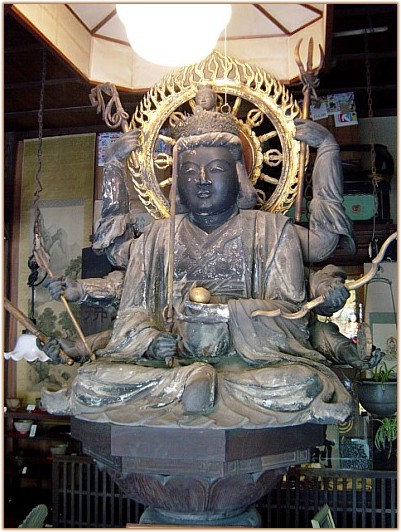
Wooden Statue, Meiji Era
Found statue inside store near Tsurugaoka Hachimangu, Kamakura
Images of Benzaiten often show her with eight arms,
holding objects such as bow, arrow, wheel, sword, key, lock, and
sacred jewel; sometimes two of the hands are folded in reverent prayer.

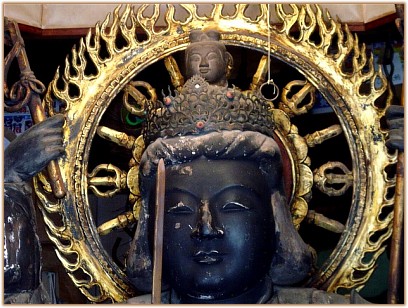
Closeup of prior photo
Benzaiten wooden statue inside Kamakura store
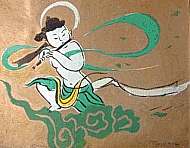
Click here for modern Japanese paintings
of Benzaiten by Oda Mayumi

SUTRAS
Benzaiten appears in the Konkomyo-o-kyo (金光明最勝王経, translated into Chinese by Yijing 義浄 in the 7th century AD) where she was the sister of Enma-ten (Yamaraja), the King of the Buddhist hells, from where her worship began in China in the 8th century. In the Konkomyo-saisho-o-kyo Sutra in Japan, she is said to protect those who possess this sutra and to help them acquire all sorts of material gain. (source: Flammarion Iconographic Guides, Buddhism).

BELOW TEXT COURTESY OF:
www.japan-101.com/culture/benzaiten_japanese_goddess.htm
Benzaiten is the Japanese name of Sarasvati (also read "Saraswati"), which was originally a mighty river in ancient India (see Vedic Saraswati River). Later she became the eponymous deity of that river. Benzaiten arrived in Japan during the 6th through 8th centuries, mainly via the Chinese translations of the Sutra of Golden Light (金光明經), which has a section devoted to her. She is also mentioned in the Lotus Sutra. As a river-deity, she came to be the goddess of everything that flows: words (and knowledge, by extension), speech, eloquence, and music. The characters used initially to write her name, read Biancaitian in Chinese and Benzaiten in Japanese (辯才天), reflected her role as the goddess of eloquence. Because the Sutra of Golden Light promised protection of the state, in Japan she became a protector-deity, at first of the state and then of people. Lastly she became one of the Seven Gods of Fortune, and the Sino-Japanese characters used to write her name changed to 弁財天 (no change in pronunciation), which reflects her role in bestowing monetary fortune. She is enshrined on the Island of Enoshima (江の島) in Sagami Bay, about 50 kilometers south of Tokyo, and she and a dragon are the central figures of the Enoshima Engi (江嶋縁起), a history of the shrines on Enoshima written by the Japanese Buddhist monk Kokei (皇慶) in 1047 A.D. For more details on the Enoshima Engi, please click here (outside linke).

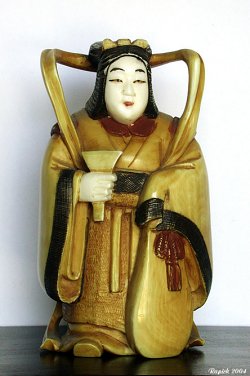
Ivory Benzaiten in collection of
Andres Bernhard AKA Rapick - Italy
Date Unknown

MONEY-WASHING TRADITION
The Zeniarai Benten Shrine (outside link) in Kamakura City is devoted to the goddess Benzaiten. At this shrine, believers "wash" their money in water to make it reproduce and increase. But there is another deity, known as Fudo Myou-ou, who can work the same miracle.
This money-washing tradition is easy to understand for Benzaiten. She is the goddess of fortune, and shrines/temples devoted to her are always located near water (river, pond, lake, ocean). She is associated with the NAGA (serpents and dragons), who guard treasure.
But why Fudo Myou-ou? His real symbol is fire. His aureole is almost always the flames of fire. He is also the main honzon for GOMA 護摩, a fire ceremony still popular today in which defilements are symbolically burnt away.
So why would people wash money under Fudo's protection? Because he washes away impurities? Maybe, perhaps, because drawings of Fudo show him standing on a rock rising from the sea? For example, the drawing at Daigoji 醍醐寺, Kyoto, and the famous 1282 drawing by Shinkai 信海 of Fudou standing on a rock rising from the sea. Moreover, Kurikara, a dragon wound around a sword, may appear in paintings of Fudou. Also, both Kurikara and Fudou are found often near ascetic practice places, such as small waterfalls. Perhaps this is the reason. For more details on this topic, see the Fudo Money Washing Page (outside link) by Gabi Greve.

OTHER GODDESSES OF WEALTH & FORTUNE
In Japan, the goddess Marishiten (of Hindu origin) is revered as a tutelary deity of the warrior class. In later centuries, like Benzaiten, she was worshipped as a goddess of wealth and prosperity among merchants. She was counted along with Daikokuten 大黒天 and Benzaiten 弁財天 as one of a trio of "three deities" (Santen 三天) invoked for good fortune during the Edo period. Marishiten is a member of the TENBU group, but her place among Japan’s Seven Lucky Deities was supplanted by Benzaiten.
In addition, the worship of another goddess of fortune, Kichijouten, has been replaced by worship of Benzaiten. Kichijouten is the wife of Vishnu in Hindu myths. She is also the wife or sister of Bishamonten in Buddhist myths. In Japan she is the goddess of fortune, luck, beauty, and merit. Among some Japanese sects, she was the central devotional deity, given individual status as an object of Buddhist worship. However, since the 15th/16th century, her imagery and attributes were largely supplanted by the Goddess Benzaiten (this page).
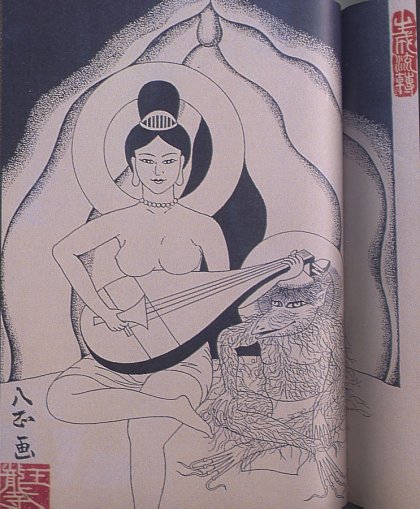
Benzaiten and Kappa
Modern. Found at this web site.

The above photo shows BENZAITEN, the Goddess of the Sea, who by tradition in Japan, is often shown playing a biwa (Japanese mandolin). Next to her is the Kappa, a Japanese water imp. Benzaiten’s temples and shrines are almost invariably in the neighborhood of water -- the sea, a river, or a pond. She is often represented as a beautiful woman with the power to assume the form of a serpent, or shown seated on a dragon or serpent and playing a lute. In fact, the snake is almost always associated with Benzaiten, who was originally a Hindu deity (Sarasvati) who represented learning, music and poetry. Since the Kamakura era, statues and paintings of Benzaiten have often depicted her naked.
WHY IS THE KAPPA HERE? Well, that is not so easily explained. The Kappa is not typically associated with Benzaiten. But there is one potential answer -- the Kappa is a Suijin (water kami, water deity) in Shinto mythology. Suijin are found in lakes, ponds, springs, wells, and irrigation waterways. They are often depicted as a snake, a dragon, an eel, a fish, a turtle, or a kappa.
This association with water is probably what the artist is trying to achieve -- both Benzaiten and the Kappa are spirits who are closely associated with water. Perhaps the artist wants to show the beautiful and ugly side of the spirit world, that a deity can come in both dark and light forms, both bad and good forms, etc. The two appear to be sitting at the entrance to a cave (another common motif associated with Benzaiten), but readers at the web site where this photo was found think it may be a vagina. This may or may not be correct. But the close association of Benzaiten with the snake (see text above), especially the imagery of the snake shedding its skin, may indicate the idea of rebirth and renewal. And what better motif than the female sexual organ.

Ugajin 宇賀神
Other Names: Uka no kami, Uga no mitama, Uka no mitama
Text Courtesy Kokugakuin University Database
An obscure kami worshiped as a deity of fortune from the early medieval period on. Fused with the Buddhist deity Benzaiten, the kami became known as Uga Benten, and was also called by the titles Uga Shinnō ("divine-king Uga") and Uga Shinshō ("divine-commander Uga"). The kami's name has been conjectured to derive from the Sanskrit ugaya but most sources suggest that it originated in the tutelary of foodstuffs Uka no mitama as found in Kojiki and Nihongi, and that it was thus originally worshiped as a grain spirit or deity of good fortune.
The features of this deity took on a unique evolution as the result of undergoing amalgamation with the deity Benzaiten as part of the doctrinal development of the Tendai sect on Mt. Hiei. Vol. 36-37 of the Keiran Shūyōshū, which collects oral legends of Mt. Hiei (compiled in +1317), includes numerous stories regarding Uga Benten. During the mid-Kamakura period, Kenchū, a monk of the esoteric Tendai group Anōryū, compiled the collection of esoteric practices called Saishō gogoku ugaya tontokunyoi hōjuō shūgi, indicating that the sect's doctrines regarding Uga Benzaiten had already achieved substantial systematization by this time. Numerous Buddhist scriptures and other writings discuss Benzaiten; among them
- Bussetsu saishō gokoku Uugaya tontoku nyōi hoju darani-kyō
- Bussetsu sokushin bontenfukutoku enman Ugajinshō Bosatsu hakujaku jigen mikka jōju-kyō
- Bussetsu Ugajin'ō fukutoku enman darani-kyō
The later came to be called the "three sutras of Benzaiten." With the addition of Bussetsu Dai Uga Kudoku Benzaiten-kyō and Dai-Benzaiten nyo darani-kyō, the group are sometimes called the "five sutras of Benzaiten," though they are all today considered apocrypha. Their contents depict the deity in the form of a heavenly woman with eight arms, holding a spear, wheel treasure, treasure bow, treasure-gem, sword, club, lock, and arrow. A white snake with the face of an elderly human rests on her head, and she leads fifteen child-deities as escorts. Devotion to Uga Benten is said to be repaid by the receipt of infinite blessings.
These depictions differ greatly from the conventional portrait of Benzaiten found in the sutras Dainichikyō and Saishōō-kyō, and reflect a unique development of the Benten cult in Japan. From Ōmi Chikubujima near Mt. Hiei, the cult of Uga Benzaiten spread throughout Japan, including Itsukushima in Aki, Enoshima in Sagami, and Tenkawa in Kii, and it was a popular object of worship as a god of fortune among the masses of the Edo period. Ugajin was also adopted within Japanese Onmyōdō and Yoshida Shinto, leading to the observation of the festival called Ugajinsai. <end quote by Itō Satoshi from Kokugakuin University>


Stone statue at private home in Kamakura, Taisho Era
Click image for larger photo.
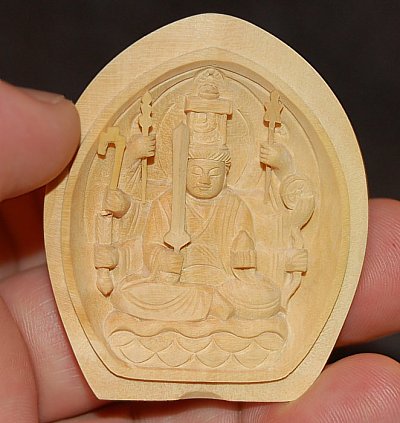
8-Armed Benzaiten wood amulet. Modern.
Available for online purchase at Buddhist-Artwork.com
SOURCES
- Butsuzō-zu-i 仏像図彙, “Collected Illustrations of Buddhist Images.” Published in 1690 (Genroku 元禄 3). A major Japanese dictionary of Buddhist iconography. Hundreds of pages and drawings, with deities classified into approximately 80 (eighty) categories. Purchase modern-day reprints of the expanded Meiji-period version here (J-site).
- Handbook on Viewing Buddhist Statues 仏像の見方ハンドブック. By Ishii Ayako. A wonderful book. Published 1998. Japanese Language Only. 192 pages; 80 or so color photos. ISBN 4-262-15695-8.
- JAANUS. Japanese Architecture and Art Net Users System. A wonderful online dictionary compiled by the late Dr. Mary Neighbour Parent. It covers both Buddhist and Shinto deities in great detail. Over 8,000 entries. Written in English, yet presenting all key terms in Japanese.
- Buddhism (Flammarion Iconographic Guides)
 , by Louis Frederic, Printed in France, ISBN 2-08013-558-9, First published 1995. A highly illustrated volume, with special significance to those studying Japanese Buddhist iconography. Includes many of the myths and legends of mainland Asia as well, but its special strength is in its coverage of the Japanese tradition. Hundreds of accompanying images/photos, both B&W and color. , by Louis Frederic, Printed in France, ISBN 2-08013-558-9, First published 1995. A highly illustrated volume, with special significance to those studying Japanese Buddhist iconography. Includes many of the myths and legends of mainland Asia as well, but its special strength is in its coverage of the Japanese tradition. Hundreds of accompanying images/photos, both B&W and color.
- Essentials of Buddhist Images: A Comprehensive Guide to Sculpture, Painting, and Symbolism. By Kodo Matsunami. Paperback; first English edition March 2005; published by Omega-Com. Above clipart in left column scanned from this book. Matsunami (born 1933) is a Jōdo-sect 浄土 monk, a professor at Ueno Gakuen University, and chairperson of the Japan Buddhist Federation. He received the government's Medal of Honor (褒章 hōshō), Blue Ribbon, for his achievements in public service. Says Matsunami: “Bishamonten protects from disaster and bodily harm. Daikoku satisfies the deisre for food. Benzaiten represents sexual desire. Hotei brings laughter, and Ebisu grants wealth.
- Tobifudo Deity Dictionary. Ryūkozan Shōbō-in Temple 龍光山正寶院 (Tokyo). Tendai Sect.
- The Seven Lucky Gods of Japan
 , by Chiba Reiko. Charles E. Tuttle Co., 1966. Also see UCLA Center for East Asian Studies, Educational Resources from teacher Samantha Wohl, Palms Middle School, Summer 2000. See Wohl’s Materials List (based on Chiba Reiko’s book). , by Chiba Reiko. Charles E. Tuttle Co., 1966. Also see UCLA Center for East Asian Studies, Educational Resources from teacher Samantha Wohl, Palms Middle School, Summer 2000. See Wohl’s Materials List (based on Chiba Reiko’s book).
LEARN MORE
This is a side page.
Return to Seven Lucky Gods Main Page.
|
|